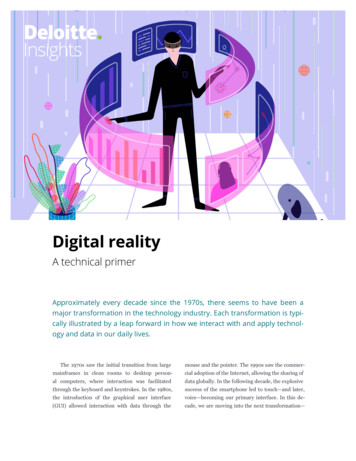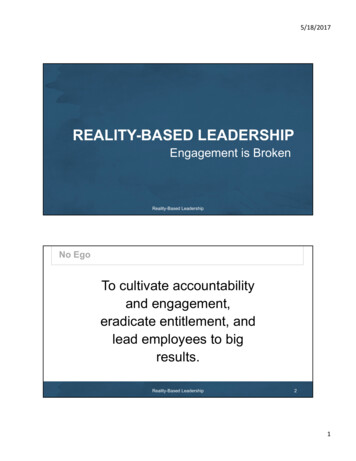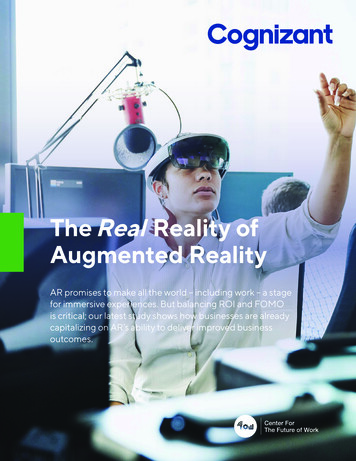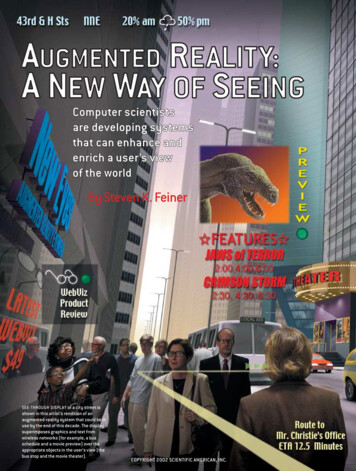
Transcription
Digital realityA technical primerApproximately every decade since the 1970s, there seems to have been amajor transformation in the technology industry. Each transformation is typically illustrated by a leap forward in how we interact with and apply technology and data in our daily lives.The 1970s saw the initial transition from largemouse and the pointer. The 1990s saw the commer-mainframes in clean rooms to desktop person-cial adoption of the Internet, allowing the sharing ofal computers, where interaction was facilitateddata globally. In the following decade, the explosivethrough the keyboard and keystrokes. In the 1980s,success of the smartphone led to touch—and later,the introduction of the graphical user interfacevoice—becoming our primary interface. In this de-(GUI) allowed interaction with data through thecade, we are moving into the next transformation—
Digital reality: A technical primerdigital realityTM, where our means of interface isTo comprehend digital reality, we need to un-expected to be the gesture, our emotions, and ourderstand the concepts that it encompasses. Whilegaze.1VR enables users to immerse themselves in artificialIn this technical primer, we refer to the gamut ofsurroundings that portray actual places or imagi-augmented reality (AR), virtual reality (VR), mixednary worlds, AR overlays contextual informationreality (MR), 360 video, and immersive experienceon the actual physical environments users see, thuscapabilities as digital reality, except when alludingcombining digital components and experiences withto the individual technology in its specific sense.2real life.4 MR characterizes the controlled impact ofIn later sections, we define these technologies andthe AR/VR and the Internet of Things (IoT) trends.describe their drivers, possible challenges in imple-MR brings together the virtual and real worlds tomentation, market potential, and some industrialgenerate new environments in which both digitalapplications.and physical objects—and their data—can coexistand interact with one another.5 360 video providesa new perspective that allows users to look in ev-Defining digital realityery direction. This is achieved by shooting with anomnidirectional camera or a collection of cameras.Digital reality is generally defined as the wideImmersive experience creates a multisensory digitalspectrum of technologies and capabilities that in-experience that can be delivered using VR, AR, MR,here in AR, VR, MR, 360 video, and the immersiveand 360 video, among other technologies.6experience, enabling simulation of reality in variousways (see figure 1).3Figure 1. The digital reality ecosystemVirtual RealityCREATES A DIGITAL ENVIRONMENTthat replaces the user’s real-world environment360o VideoAugmented RealityPROVIDES A NEW PERSPECTIVEthat allows user to look everydirectionOVERLAYS DIGITALLY-CREATEDCONTENTinto the user’s real-worldenvironmentDIGITAL REALITYSolves real-world business problemsand creates new sources ofcompetitive advantageImmersiveMixed RealityCREATES MULTISENSORY,DIGITAL EXPERIENCEBLENDS DIGITAL CONTENT INTOTHE REAL- WORLDand is delivered through any ofthese technologiesand creates an environment whereboth coexist and interactSource: Deloitte Consulting LLP, Consumer Technology Association.2Deloitte Insights deloitte.com/insights
Digital reality: A technical primerBuilding blocks ofdigital realityhim/her identify the next action. Analytics, platform computing, and network can also be importantcomponents of an overall solution.Digital reality enables the seamless use of digitalMethod of presentation: An informationinformation to make choices in real time as we ac-overload can overwhelm users, which could incomplish tasks.turn lead to poor performance. The data providedThe three key foundational elements that rein-should be sufficient but not excessive, depending onforce digital reality (figure 2) are as follows:the complexity of the application. Much of the cur-Source of data: The process begins at therent research into digital reality focuses on how topoint where information is created, taking us out-present relevant digital information in increasinglyside the territory of pure digital reality and into an-natural, easy-to-comprehend, contextual ways, soother connected technology, the IoT. Users of digi-that users can absorb it effortlessly.8tal reality need to access digital information aboutInteraction with and use of data to drivethe world in real time from various sources via sen-action: Even the right data presented in the rightsors, and communicate that information so that itway would be of no use if it doesn’t create value.can be collected, evaluated, and acted upon, whichdigital reality not only enables the display of digitalis what the IoT is all about.7 Enterprise data—cus-information, but also the control of it in increasinglytomer relationship management (CRM), enterprisenatural ways. digital reality takes the comparison ofresource planning (ERP), computer aided designhuman and machine one step further by enabling us(CAD)—can present the user with content and helpto ponder the question: “What happens if humansFigure 2. The core elements and technologies of digital reality1. Source of the data2. Presentation of thedataSensorsCamerasInternet of ThingsEnterprise DataVisual overlayAuditory cuesLive videoEnvironment3. Interacting with,and using, the dataGesturesVoice commandsGaze and attentionUserSource: Joe Mariani, Brenna Sniderman, Cary Harr, “More real than reality: Transforming workthrough augmented reality,” Deloitte University Press, July 31, 2017; adapted from the coreelements and technologies of AR.Deloitte Insights deloitte.com/insights3
Digital reality: A technical primerVirtual reality marketand the machines collaborate?” It is fundamentally The global VR market was estimated at 3.7about making the human-machine team work asbillion in 2016, and is forecast to reach 13naturally as possible.9billion by 2019 (see figure 3).14 Increasingcompatibility of smartphones with VR technol-Exploring the digitalreality market potentialogy, along with growth in the mobile gamingmarket, are opening new opportunities for VRheadset manufacturers.15In order to understand the reach of the global The VR market is further divided into hard-digital reality market in terms of numbers, we willware and software categories. The hardwareanalyze the market potential of the core AR/VR/MRcategory accounted for 85 percent of the totalelements of the digital reality ecosystem. Althoughmarket in 2016, with gaming being the majorthe AR and VR markets comprise the overwhelmingend-user segment driver. The software categorymajority of this core digital reality market, the MRcomprised 15 percent of the total market inmarket has begun to demonstrate potential, andthe same year, driven by VR-enabled apps inmay evolve in the years ahead.segments including music and entertainment,sports, and fitness.16Augmented reality marketMixed reality market The global AR market was estimated at 5.2 billion in 2016, and is expected to reach 27 bil- The global MR market was valued at 68 mil-lion by 2019 (see figure 3). The increasing pen-lion in 2016, and is forecast to exceed 300 mil-etration of 4G—and prospectively 5G, thanks tolion by 2019 (see figure 3).17 The advent of entry-strong government as well as industry supportlevel VR headsets in the market and a marketingin various countries—are key factors in achiev-push by smartphone manufacturers have boost-ing this forecasted growth.10ed MR market growth.18 The market is further segmented into the hard- The market is further divided into three categories—smart glasses, mobile devices, and head-ware and software categories. The hardwaremounted displays (HMDs) used for AR. Each ofcategory (comprising HMDs, sensors, motionthese categories is further divided into software,tracking systems, and haptic devices) accounted11hardware, and platforms.for 66 percent of the market in 2016, while the Mobile devices accounted for 48 percent of thesoftware market, comprising integrated devel-market in 2016, and as the awareness and inter-opment environment (IDE), software develop-est in AR technology increases, users viewingment kit (SDK), and web browsers, accountedAR content will likely increase with the develop-for the remaining 34 percent.19 In terms of end-user segments, aerospace andment of consumer-specific AR apps, and the risein the number of phones integrated with depth-defense, automotive, and entertainment andsensing cameras.gaming accounted for over 70 percent of the HMDs comprised 36 percent of the mar-market, while the health care and retail and e-ket and are widely used in health care, aero-commerce segments accounted for the remain-space and defense, and commercial anding market share.20industrial operations.12 Smart glasses accounted for 16 percent of themarket in the same year, with the enterprise sector being the major adopter.134
Digital reality: A technical primerFigure 3. Global digital reality market size ( billion) (broken by AR/VR/MR core .210.38.50.30.10.1Augmented RealityVirtual RealityMixed RealitySource: Technavio, “Global augmented reality market—2017–2021,” 2016, p. 33; Technavio, “Global virtual realitymarket—2015–2019,” 2015, p. 19; Technavio, “Global mixed reality market—2017–2021,” 2016, p. 27Deloitte Insights deloitte.com/insightsKey players in digital realityEnabling the digital realitymarket and addressing keylimitations to its growthIn terms of key players, the digital reality spacecan be divided into areas of activity:The expansion of the core digital reality market Tools/content—platforms, apps, capture tools,over the last few years can be attributed to a numberetc.of beneficial factors, some of which are discussed Application content—information from industry,below:analytics, social, etc. Infrastructure—hardware, data systems, HMDs, Proliferation of mobile apps along withetc.the increased use of smartphones: TheIncreasing investment in infrastructure maylarge-scale global adoption of smartphones, cou-drive the growth of software and content, leadingpled with a rise in the number of mobile appli-to new practical applications and, possibly, an infu-cations and the development of the applicationsion of digital reality software development talent.21and content ecosystem, has driven digital realitygrowth.22 The overall mobile app market was estimated at 61 billion in 2016, and is forecastto expand at a CAGR of 23 percent to reach 173 billion by 2021.235
Digital reality: A technical primer Increasing use of digital reality in adver-hardware components, including sensors andtising: The use of digital reality for highly im-cameras, are an added benefit.27mersive advertising and marketing is creating Improved network connectivity: Digitalopportunities for users and brands to connectreality devices require high-speed connectivityreal time with the product, driving an increaseto function smoothly, and connectivity provid-in purchases. People’s growing dependence oners are plugging the gaps in coverage using bothsmartphones is compelling many advertiserswireless and wired technology, enabling them toto focus on mobile advertising in general, thustap into the higher-frequency spectrum. Fiberenabling the increased penetration of mobilebackbones are being integrated across the globedigital reality advertising.24The mobile AR ad-to ease bottlenecks to speed.28 Tetherless access: Thanks to improvementsvertising market was estimated at 1.1 billionin 2016 and is expected to reach 20 billion inin underlying design in digital reality technol-2021.25 Companies have also started using digi-ogy, a new generation of devices is emergingtal reality-powered kiosks in stores to marketthat offers users the benefit of a self-containedtheir products.26experience free of tethering wires or unwieldy Declining average selling price (ASP)battery packs. Such advances may lead to theof digital reality hardware: As many largeuser “wearing” a digital reality device in muchenterprises commercialize their solutions, thethe same manner as a watch or a cellphone. TheASPs of smart glasses and HMDs are forecast toincrease in battery life also contributes to thedecline. In terms of presentation of data (as dis-unencumbered digital reality experience.29 Capital funding: There is little doubt thatcussed in the digital reality framework), the useof low-cost, energy-efficient micro displays spe-deep-pocket players are investing in use casescifically designed for tablets and smartphonesacross the digital reality spectrum. There ap-could further improve the digital reality mar-pears to be much investment activity in suchket’s growth. Declining prices of data- sourceareas as gaming, with one estimate suggestingnearly 10 billion in capital investment by 2021.Table 1. Key challenges to the growth of digital reality and potential solutionsChallengesPotential solutionsDigital reality requiressubstantial computingpower to create highquality graphics.31Development of dedicated processing units can increase computing power andspeed while reducing power consumption.32Human field of viewcan extend to 180degrees; current digitalreality hardware hasa limited field of viewup to 100 degrees.33Increasing the field of view toward 180 degrees would expand a worker’s observableenvironment and enable more immersive experiences.34There are cyber riskconcerns related toAR/VR technology.35AR/VR devices may need to be tracked and securely managed to control accessto underlying data and applications and entitlement rights to the gear. Existingcyber protocols from mobile device, application, and data management programsshould be adopted to create the necessary AR/VR management.36 High-definition 3Drenderings of facilities and detailed equipment tracking may need to be encrypted toprovide protection.376Deloitte Insights deloitte.com/insights
Digital reality: A technical primerDefenseOther areas of interest include retail showcasing, AR is being extensively used by the military foron-site assembly and safety, process manufac-more effective training of soldiers.41turing training, and travel/hospitality.30 Smart helmets allow commanders to sendWhile we have discussed some of the key factorsmaps and other information directly to the sol-influencing the growth of the digital reality market,diers’ field of vison, enabling them to performwe should also be aware of hurdles to the adoptiontheir missions with enhanced safety, speed,of digital reality applications and evaluate potentialand coordination.42 MR applications in the future may involvesolutions.drones small enough to fit into the palm of asoldier’s hand. The drones can then track andApplying digital realityto industriesanalyze a soldier’s movements under a trainingsimulation and real-world combat situations.43AutomotiveAn increasing number of industries outsidegaming and entertainment have started testing and AR often plays a crucial role in vehicle design.adopting digital reality technologies for various ap-Manufacturers can use the technology to com-plications. Some of the current and potential digitalpare virtual data with the actual vehicle design,reality-related applications are described below:perform analysis, and, on that basis, potentiallyalter parts during the initial stages of designAerospaceplanning. In this way, the technology can pro- AR devices such as smart glasses allow engineersvide manufacturers with an exact picture of ato provide guidance on complex tasks to main-car’s future performance, possibly reducing timetenance workers in remote locations and at theand cost of launch.44 Potential applications of AR, such as projectingsame time view a real-time and interactive demonstration of the repair job.navigation routes and distance between the car38 VR can help address the shortage of skilled engi-and road obstacles or pedestrians, may be dis-neers for maintenance, repair, and overall oper-played on car windshields instead of traditionalations (MRO) by augmenting local engineeringdashboard screens, allowing the driver’s visionskills with the expertise of more qualified techni-to stay on the road.45cians from any location at any time, potentially Carmakers are also experimenting with MRreducing training time, improving maintenancetechnology that enables them to combine and vi-efficiency, and enabling huge cost savings.39sualize physical vehicles and computer imaging Aircraft component manufacturing companiesto improve design and speed up development.46are developing MR applications, with which theHealthcareposition of engineers installing equipment in- VR can potentially enable surgical specialistsside aircraft fuselages can be mapped to a fullscale 3D digital model of the aircraft they areto treat patients remotely using a remote-con-working on. This enables engineers to instantlytrolled robot. Using an HMD and haptic gloves,bring up an image of an aircraft component in-a surgeon could virtually perform a surgerystallation and can help them ensure that theythousands of miles away.47have fixed it correctly.407
Digital reality: A technical primer MR is being used for the preoperative prepara-also need to improve connectivity—in the form oftory phase of surgical procedures, where sur-wired, wireless, and cellular—to cater to digital re-geons can plan the entire operation using 3Dality requirements in remote locations. Companiesholograms, decide on where to make incisions,should consider investing in new tools and servicesand also see the consequences of their moves.48such as high-definition 3D image capture, mappingequipment, and high-end gaming engines, to recre-Consumer products and servicesate simulations and virtual environments for digital AR allows online shoppers to view products suchreality interaction.54as clothes, furniture, and other items in 3D in aAdditionally, change management can be essen-real-life environment, in real time through theirtial for organizations to train their workforces andtablets or smartphones before purchasing.49make them technology-ready. The use and adop- Travelers can explore scenic places, cities,tion of such digital reality tools as smart glassesor hotels in a travel destination through aand HMDs could position organizations to takeVR headset.50advantage of digital reality applications to increasethe effectiveness of training and enable productionefficiencies.55Key considerationsfor organizationsSimply put, organizations can use digital realitycapabilities to their full potential to streamline theirworkflow, drive collaboration and productivity, andAs companies extract value from informationenhance the customer experience—and, in the pro-gathered during the execution of daily tasks, siftingcess, perhaps build brand value.through voluminous amounts of data for a complex operation may soon surpass the competency ofFinal thoughtsmost people.51 digital reality would thus become increasingly essential for processing this data as wellas dealing with the variability of the task (when eachThe application of digital reality today appearsiteration of a task is different). Digital reality tech-to go well beyond the consumer segment, with anologies offer various prospects for enterprises toreach that extends across the enterprise world. Ac-transform areas such as internal workforce commu-cordingly, businesses should consider investing innication and collaboration, workforce training andinfrastructure and developing new operating mod-simulation, and customer service.52 The combinedels to improve connectivity and fast track the adop-effect of factors, including declining hardware andtion of digital reality technologies. Indeed, digitalsoftware costs, increased smartphone usage, andreality is swiftly progressing from hype to reality,creation of app ecosystems, have led to the prolifer-as is evident from the market growth realized overation of digital reality applications in both consum-the years, offering a plethora of benefits to organiza-er and enterprise segments as discussed earlier.tions. The time seems apt for the full array of busi-53With the advent of digital reality solutions, en-ness professionals—from product planners to strat-terprises may need to upgrade their infrastructureegists to marketing and beyond—to understand theby installing sensors and beacons, among otherdisruptive potential of digital reality and put thesystems, to facilitate augmented setups. They maytechnology to use.8
Digital reality: A technical primerENDNOTES1.Sophie Charara, “Everything you need to know about augmented reality: Then, now & next,” Wareable, May 17,2017.2.Deloitte, Augmented/virtual reality next big thing of digital environment, November 2017, accessed November 8,2017; Allan Cook et al., Digital reality: The focus shifts from technology to opportunity, Deloitte Insights, December5, 2017.3.Ibid.4.Nelson Kunkel, Steve Soechtig, Jared Miniman, and Chris Stauch, Augmented and virtual reality go to work, DeloitteUniversity Press, February 24, 2016.5.Nelson Kunkel and Steve Soechtig, Mixed reality: Experiences get more intuitive, immersive, and empowering,Deloitte University Press, February 7, 2017.6.Cook et al., Digital reality.7.For more information on IoT, please refer to the IoT collections page on Deloitte Insights.8.Joe Mariani, Brenna Sniderman, and Cary Harr, More real than reality: Transforming work through augmented reality, Deloitte University Press, July 31, 2017.9.Ibid.10. Technavio, “Global augmented reality market—2017–2021,” 2016, pp. 33–50.11. Ibid.12. Ibid.13. Ibid.14. Technavio, “Global virtual reality market—2015–2019,” 2015, pp.19–30.15. Ibid.16. Ibid.17. Technavio, “Global mixed reality market—2017–2021,” 2016, pp. 27–43.18. Ibid.19. A haptic device is one that involves physical contact between the computer and the user, usually through aninput/output device, such as a joystick or data gloves that sense the body’s movements. By using haptic devices,the user can not only feed information to the computer but can also receive information from the computer inthe form of a felt sensation on some part of the body; An integrated development environment (IDE) is a software application that provides comprehensive facilities to computer programmers for software development; Asoftware development kit (SDK) is a set of software development tools that allows the creation of applications,software framework, video game console, operating system, etc.20. Technavio, “Global mixed reality market—2017–2021,” 2016, pp. 27–43.21. CB Insights, “The breadth of the virtual,” September 11, 2015.22. Technavio, “Global augmented reality market—2017–2021,” 2016, p. 60.9
Digital reality: A technical primer23. Ibid.24. Technavio, “Global augmented reality market—2017–2021,” 2016, p. 62.25. Ibid.26. Elizabeth Woyke, How stores will use augmented reality to make you buy more stuff, MIT Technology Review, June17, 2016.27. Technavio, “Global augmented reality market—2017–2021,” 2016, p. 64.28. Deloitte, A quick take on the future of connectivity, accessed November 8, 2017.29. Cook et al., Digital reality.30. Ibid.31. Ryan Kaiser and David Schatsky, For more companies, new ways of seeing, Deloitte University Press, April 5, 2017.32. Ibid.; Dedicated processing units are used to store and process data locally, improving theirperformance substantially.33. Kaiser and Schatsky, For more companies, new ways of seeing.34. Ibid.35. Kunkel and Soechtig, Mixed reality.36. Ibid.37. Ibid.38. Kevin Deal, “Commercial aviation MRO using augmented reality, virtual reality to bridge skills shortage gap,”Intelligent Aerospace, February 24, 2017.39. Ibid.40. Woodrow Bellamy III, “9 companies using augmented and virtual reality in aviation,” Avionics, August 24, 2017.41. National Interest, “How the U.S. military is using augmented reality to bolster troop readiness,” August 13, 2017.42. Mark Prigg, “Google Glass for war: The US military funded smart helmet that can beam information to soldierson the battlefield,” Daily Mail, May 27, 2014.43. Elizabeth Lee, “Experimental virtual and mixed reality technologies can be applied to military of the future,”Silicon Valley and Technology, October 19, 2017.44. Autocar, “Volkswagen develops virtual tech to speed up car design,” March 21, 2017.45. Automotive IQ, “Getting a better view—augmented reality in cars,” March 27, 2017.46. Futurism, “Ford is using Microsoft’s HoloLens to design cars in mixed reality,” September 22, 2017.47. Reality Technologies, “How reality technology is used in healthcare,” accessed October 27, 2017.48. TMF, “Mixed reality in healthcare—The HoloLens review,” accessed October 27, 2017.49. Christopher Luu, “Ikea’s new app lets you see how its furniture will look in your actual house,” Refinery 29, September 25, 2017.50. Joseph Bien-Kahn, “Virtual reality lets you arrive without traveling,” Wired, November 21, 2016.51. Mariani, Sniderman, and Harr, “More real than reality.”10
Digital reality: A technical primer52. Kunkel, Soechtig, Miniman, and Stauch, Augmented and virtual reality go to work.53. Ibid.54. Mariani, Sniderman, and Harr, “More real than reality.”55. Ibid.ACKNOWLEDGEMENTSThis paper would not have been possible without the diligent contributions of Monika Mahto andHemnabh Varia of Deloitte Services India Pvt. Ltd. It also greatly benefitted from the support of AllanCook and Kaitlyn Kuczer of Deloitte Consulting LLP. Jonathan Holdowsky of Deloitte Services LP provided overall support and editorial guidance in the development of this paper.CONTACTSAllan CookHead of Strategy & Operations, Digital RealityManaging directorDeloitte Consulting LLP 1 310 400 2060allcook@deloitte.comMark CotteleerResearch directorCenter for Integrated ResearchDeloitte Services LP 1 414 977 2359mcotteleer@deloitte.comJonathan HoldowskySenior managerCenter for Integrated ResearchDeloitte Services LP 1 617 437 3198Digital Reality—which consists of augmented reality (AR), virtual reality (VR), mixed reality (MR),360o video, and immersive technologies—is rapidly gaining traction in the marketplace and maydrastically transform how we work, communicate, learn, and create. The proliferation of thesetools, applications, and solutions will permeatethroughout everyday life and work in just a fewyears and will be as impactful as the PC, web, andmobile. This has led to digital reality’s reputationas the next technology transformation in theway people interact and use data. Companiesaround the world are applying these technologies to create revenue-generating and cost-saving solutions as well as wholesale changes to theway they work. For more information about ourdigital reality offering, please visit com11
Sign up for Deloitte Insights updates at www.deloitte.com/insights.Follow @DeloitteInsightContributorsEditorial: Ramani Moses, Nikita Garia, Preetha DevanCreative: Anoop K R, Kevin Weier, Tushar BarmanPromotion: Devon MychalArtwork: Mengxin LiAbout Deloitte InsightsDeloitte Insights publishes original articles, reports and periodicals that provide insights for businesses, the public sector andNGOs. Our goal is to draw upon research and experience from throughout our professional services organization, and that ofcoauthors in academia and business, to advance the conversation on a broad spectrum of topics of interest to executives andgovernment leaders.Deloitte Insights is an imprint of Deloitte Development LLC.About this publicationThis publication contains general information only, and none of Deloitte Touche Tohmatsu Limited, its member firms, or itsand their affiliates are, by means of this publication, rendering accounting, business, financial, investment, legal, tax, or otherprofessional advice or services. This publication is not a substitute for such professional advice or services, nor should it beused as a basis for any decision or action that may affect your finances or your business. Before making any decision or takingany action that may affect your finances or your business, you should consult a qualified professional adviser.None of Deloitte Touche Tohmatsu Limited, its member firms, or its and their respective affiliates shall be responsible for anyloss whatsoever sustained by any person who relies on this publication.About DeloitteDeloitte refers to one or more of Deloitte Touche Tohmatsu Limited, a UK private company limited by guarantee (“DTTL”), itsnetwork of member firms, and their related entities. DTTL and each of its member firms are legally separate and independententities. DTTL (also referred to as “Deloitte Global”) does not provide services to clients. In the United States, Deloitte refers toone or more of the US member firms of DTTL, their related entities that operate using the “Deloitte” name in the United Statesand their respective affiliates. Certain services may not be available to attest clients under the rules and regulations of publicaccounting. Please see www.deloitte.com/about to learn more about our global network of member firms.Copyright 2018 Deloitte Development LLC. All rights reserved.Member of Deloitte Touche Tohmatsu Limited
Source Technavio, "lobal augmented reality maret20172021, 2016, p. 33; Technavio, "lobal virtual reality maret20152019, 2015, p. 19; Technavio, "lobal mixed reality maret20172021, 2016, p. 27 igure 3. Global digital reality market size billion broken by A/V/M core segments 2019F 2018F 2017E 2016 Augmented Reality Virtual Reality Mixed .










